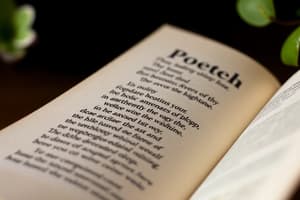Podcast
Questions and Answers
What is a defining feature of poetry?
What is a defining feature of poetry?
- Use of images exclusively
- Use of factual statements
- Use of language to evoke emotions and memories (correct)
- Use of numbers to convey meaning
Which type of poem typically consists of 14 lines divided into two stanzas?
Which type of poem typically consists of 14 lines divided into two stanzas?
- Epic
- Sonnet (correct)
- Limerick
- Ballad
What themes do sonnets often explore?
What themes do sonnets often explore?
- Love, beauty, and mortality (correct)
- Historical events
- Technology and progress
- Nature and wildlife
What is the structure of a traditional Haiku poem?
What is the structure of a traditional Haiku poem?
Which type of poem does not adhere to a strict meter or rhyme scheme?
Which type of poem does not adhere to a strict meter or rhyme scheme?
What is the purpose of poetry's use of rhythm, rhyme, and verse structure?
What is the purpose of poetry's use of rhythm, rhyme, and verse structure?
What aspect of poetry should readers pay attention to in order to understand the tone and mood of a poem?
What aspect of poetry should readers pay attention to in order to understand the tone and mood of a poem?
Which sound devices can contribute to the musicality of a poem?
Which sound devices can contribute to the musicality of a poem?
What type of poetry is famous for its rural and pastoral imagery?
What type of poetry is famous for its rural and pastoral imagery?
Which poet is primarily recognized as a playwright but also wrote sonnets and poems?
Which poet is primarily recognized as a playwright but also wrote sonnets and poems?
What does exploring alliteration, assonance, and consonance in a poem help to enhance?
What does exploring alliteration, assonance, and consonance in a poem help to enhance?
What should a poet focus on to enhance a reader's understanding of their poem?
What should a poet focus on to enhance a reader's understanding of their poem?
Flashcards are hidden until you start studying
Study Notes
English Language: A Comprehensive Guide to Poetry
The English language is multifaceted and dynamic, with diverse literary forms that reflect human experiences and emotions. One such form is poetry, which has been around since ancient times. In this article, we will explore the fascinating world of poetry within the context of the English language.
What Is Poetry?
Poetry is a type of literature characterized by its use of language to evoke images, emotions, thoughts, and memories. It often uses rhythm, rhyme, and verse structure to convey meaning beyond the surface level. While there are variations across cultures and time periods, poetry generally aims to create aesthetic pleasure through the use of language.
Types of Poetry
There are several types of poems found in the English language's poetic traditions:
-
Sonnet: This poem typically consists of 14 lines divided into two stanzas, with three quatrains followed by a couplet. Sonnets often deal with themes of love, beauty, and mortality.
-
Haiku: These traditional Japanese poems consist of three short lines containing five syllables each in the first line, seven in the second, and five in the third. Haikus focus on nature and seasonal changes.
-
Free Verse: Unlike other poems, free verse does not follow any strict meter or rhyme scheme. Instead, it relies on the natural rhythms of speech and is often used to express more personal or emotional experiences.
Famous English Poems and Poets
Throughout history, many notable poets have written some of the most celebrated works in the English language. Here are just a few examples:
-
William Shakespeare: Known primarily as a playwright, Shakespeare also wrote numerous sonnets and poems. His work frequently explores themes of love, loss, and mortality.
-
John Keats: This Romantic poet crafted intense and sensuous lyrics filled with melancholy and yearning.
-
Robert Frost: An American poet famous for his rural, pastoral imagery, Frost explored complex moral and social issues through everyday life situations.
-
Tennyson: Another Victorian English poet, Tennyson wrote epic narrative poems dealing with love, death, and mankind's place in the universe.
Reading and Understanding Poetry
To appreciate poetry, readers need to consider different aspects of the text:
- Images: Pay attention to visual descriptions, as they can help you understand the tone and mood of the poem.
- Sound and Rhythm: Notice how sounds like alliteration, assonance, and consonance shape the poem's soundscape, contributing to its music.
- Meaning: Read between the lines; sometimes the true meanings lie underneath what seems obvious.
- Structure: Look out for patterns in the poem's organization, whether it be a specific form or a more general flow.
Writing Poetry
If you're interested in creating your own poems, here are some tips to get started:
- Choose a Topic: Pick something meaningful to you or that resonates with your life experience.
- Find a Form or Structure: Research popular forms like sonnets or haikus if you want to stick to tradition. Otherwise, feel free to experiment with free verse.
- Focus on Imagery: Create vivid pictures with your words to enhance your reader's understanding.
- Use Sound Devices: Employ techniques like alliteration, assonance, and consonance to give your poem musicality.
In conclusion, poetry in the English language provides a unique means of expression, allowing us to explore universal truths about love, life, and existence. By engaging with the various types of poetry—from sonnets to free verse—we gain insight into our shared humanity while expanding our appreciation for the richness of the English language itself.
Studying That Suits You
Use AI to generate personalized quizzes and flashcards to suit your learning preferences.




